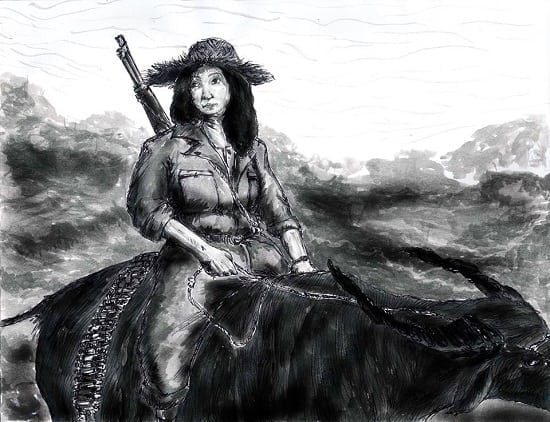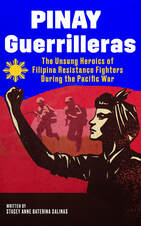- Home
- Stories
-
Internship
- Summer 2024 Internship
- Summer 2023 Internship
- Fall 2022 Internship
- Summer 2022 Internship
- Summer 2021 Internship
- Fall 2020- Spring 2021 Internship
- Summer 2020 Internship
- Fall 2019 Internship
- Summer 2019 Internship >
- School Year 2018-2019 Internship
- Summer 2018 Internship >
- Fall 2017 Internship
- Summer 2017 Internship >
- Books
- Archives
-
Resource Page
-
Supplementary Research Guides
>
- Unit 731 - Guide >
-
Philippines' Resistance - Guide
>
- Philippines World War II Timeline
- The Japanese Invasion & Conquest of the Philippines
- Bataan Death March
- Formation of Underground Philippines Resistance
- Supplies of the Guerrilla Fighters
- The Hukbalahap
- Hunter's ROTC
- Marking's Guerrillas
- United States Army Forces in the Philippines of Northern Luzon (USAFIP-NL)
- The Aetas
- Chinese and Filipino-Chinese Nationalist Guerrilla Units
- The Female Faces of the Philippine Guerrillas
- Rising Sun Flag - Guide >
- Pinay Guerrilleras - Guide >
- Fall of Singapore - Guide >
- Three Years and Eight Months - Guide >
- Siamese Sovereignty - Guide >
- The Khabarovsk War Crimes Trial - Guide >
- Unit 731 Cover-up : The Operation Paperclip of the East - Guide >
- Marutas of Unit 731 - Guide >
- Prince Konoe Memoir - Guide >
- Competing Empires in Burma - Guide >
- Battle of Shanghai - Guide >
- Ishi Shiro - Guide >
- Taiwan The Israel of the East - Guide >
- Seeking Justice for Biological Warfare Victims of Unit 731 - Guide >
- Rice and Revolution - Guide >
- Clash of Empires - Guide >
-
Hunger for Power and Self-SufficiencyI - Guide
>
- The Influence of War Rations on Post-War Culinary Transformations
- How World War II Complicated Food Scarcity and Invention
- American Military Innovations
- Government-Sponsored Food Inventions in Europe during World War II
- Feeding the Army: The Adaptation of Japanese Military Cuisine and Its Impact on the Philippines
- Mixed Dishes: Culinary Innovations Driven by Necessity and Food Scarcity
-
Denial A Quick Look of History of Comfort Women and Present Days’ Complication - Guide
>
- The Comfort Women System and the Fight for Recognition
- The Role of Activism and International Pressure
- The Controversy over Japanese History Textbooks
- The Sonyŏsang Statue and the Symbolism of Public Memorials
- Activism and Support from Japanese Citizens
- The Future of Comfort Women Memorials and Education
- Echoes of Empire: The Power of Japanese Propaganda - Guide >
- Lesson Plans >
-
Supplementary Research Guides
>
THE FIERCE HENERALAS AND KUMANDERS OF THE HUKBALAHAP CUERRILLAS
The Formation of Huk
The Hukbalahap began as a socialist organization composed of a diverse cast of laborers and grassroots activists; peasant farmers, workers’ unions, communist party members, and both urban and rural laborers. The founders and party members hailed from both the Socialist and Philippine Communist Party, and throughout the 1930s, prior to the Japanese occupation, served as active nationalists and revolutionaries who sought an independent communist Philippine state. The leader of the Philippines' first official communist organization, the Worker’s Party, was Crisanto Evangelista. It was not until after the Japanese capture and executions of Evangelista and his head deputy, Abad Santos, that Evangelista’s communist and socialist guerrillas unified in addressing themselves officially as the Hukbalahap in 1942. The name of their resistance branch, Hukbalahap, translates to “people who are against the Japanese” or “the people’s army against the Japanese.
Filipina in Huk
Originally, the Huks only intended to recruit men for their organization. The first women who joined their ranks were family members of its male recruits. As the war progressed, more women—whose family members were involved with the Huk resistance—decided to join voluntarily. Male recruits were usually trained as foot soldiers or officers. Women, on the other hand, were relegated to support roles, such as secretarial, propaganda, or medical-related fieldwork. The vast majority of the Huk movement’s female medical personnel worked as nurses.
War gave Huk women the opportunity to take on important roles that once were deemed suitable only for men. Like most underground resistance militaries, the Huks were constantly short of resources, meaning they had to rely a great deal on Filipina labor to make up the difference. Large female support staff meant that more Filipino male guerrillas were available to serve in combat roles. Filipinas supported the underground resistance not only by providing medical care for male combatants, but, perhaps more importantly, by maintaining lines of communication and building networks of the barrio, village, and town support for the guerrilla cause.
Filipina Huks were tasked with winning over locals, convincing villagers and townspeople to defy the occupying Japanese troops, and, most importantly, to provide the basic necessities such as food, medical supplies, and temporary housing and cover for the guerrillas. Therefore, the critical efforts of Huk women—who provided the means for collecting the essentials for the Resistance—reveals the crucial role that female laborers played. Without the dedicated women operating as nurses, support staff, ralliers, and community contacts, the Huk resistance would not have gained enough momentum, and thus, would not have been as much of a threat to the Japanese occupation.
Felipa Culala of Candaba, Kumander Dayang Dayang
Culala was the only woman founder and elected member of the Military Committee of the Hukbalahap. Culala’s military rank afforded her the title of Kumander Dayang-Dayang, a name attributed to a famous Moro princess that translates to “a Princess of the First Degree.” The title “Dayang-Dayang” thus had a deeper historical background that further reinforced her leadership position amongst the Huks. She served as the only woman elected to the Hukbalahap Military Committee, where she operated as the head of Huk guerrilla units situated in the East Pampanga District of Luzon.
Accounts of those who worked with Felipa paint her in two radically different depictions: one as a strong leader who had a commanding presence, and another as an overbearing, haughty, conceited, and power-hungry woman who did not heed the Huk rules of conduct. It would be the latter depiction that came to define (and plague) Culala’s legacy. Eventually, Culula’s behavior became so disruptive to the Huk movement that her comrades put her on trial, convicting her of both tyranny and stealing supplies from helpless barrios, resulting in her execution by firing squad for such unwanted “behavior.”
The difficulty in finding solid resources on Culala, along with the surviving depictions of her “infamous” and “excessive” behavior that attack her based on characteristics attributed directly to her gender, reveals the excessive barriers of discrimination that Filipina guerrillas faced. Nonetheless, Culala remains the highest-ranked woman in the Huk resistance. As such, she should be remembered not only for her contributions to the underground resistance but also as a symbol for feminist Filipina empowerment.
|
Pinay Guerrilleras: The Unsung Heroics of Filipina Resistance Fighters During the Pacific War
December 8th, 1941 marked the start of the full-scale invasion of the Philippines. With the surrender of the Bataan Peninsula and the fortified island Corregidor in the Spring of 1942, all hope seemed lost. But, almost overnight, the Philippine underground resistance began to take shape. Units made up of guerrilla volunteers from all walks of life participated in the liberation of the Philippines. The women guerrillas of the resistance, or guerrilleras, are one such group who have received less attention in Pacific Theater histories. The names and faces of those Filipina guerrilla soldiers, who led their own units, conducted espionage, nursed the wounded, led raids, or raised armies, have nearly been forgotten. The rigid gender barriers guerrilleras faced both on and off the field of duty resulted in their stories being silenced or relegated to less commanding roles in the aftermath of the war. This book attempts to bring these stories to light so that the legacy of these unsung Filipina resistance fighters lives on.
|
|
Pacific Atrocities Education
730 Commercial Street San Francisco, CA 94108 415-988-9889 |
Copyright © 2021 Pacific Atrocities Education.
We are a registered 501 (c)(3) charity. |
- Home
- Stories
-
Internship
- Summer 2024 Internship
- Summer 2023 Internship
- Fall 2022 Internship
- Summer 2022 Internship
- Summer 2021 Internship
- Fall 2020- Spring 2021 Internship
- Summer 2020 Internship
- Fall 2019 Internship
- Summer 2019 Internship >
- School Year 2018-2019 Internship
- Summer 2018 Internship >
- Fall 2017 Internship
- Summer 2017 Internship >
- Books
- Archives
-
Resource Page
-
Supplementary Research Guides
>
- Unit 731 - Guide >
-
Philippines' Resistance - Guide
>
- Philippines World War II Timeline
- The Japanese Invasion & Conquest of the Philippines
- Bataan Death March
- Formation of Underground Philippines Resistance
- Supplies of the Guerrilla Fighters
- The Hukbalahap
- Hunter's ROTC
- Marking's Guerrillas
- United States Army Forces in the Philippines of Northern Luzon (USAFIP-NL)
- The Aetas
- Chinese and Filipino-Chinese Nationalist Guerrilla Units
- The Female Faces of the Philippine Guerrillas
- Rising Sun Flag - Guide >
- Pinay Guerrilleras - Guide >
- Fall of Singapore - Guide >
- Three Years and Eight Months - Guide >
- Siamese Sovereignty - Guide >
- The Khabarovsk War Crimes Trial - Guide >
- Unit 731 Cover-up : The Operation Paperclip of the East - Guide >
- Marutas of Unit 731 - Guide >
- Prince Konoe Memoir - Guide >
- Competing Empires in Burma - Guide >
- Battle of Shanghai - Guide >
- Ishi Shiro - Guide >
- Taiwan The Israel of the East - Guide >
- Seeking Justice for Biological Warfare Victims of Unit 731 - Guide >
- Rice and Revolution - Guide >
- Clash of Empires - Guide >
-
Hunger for Power and Self-SufficiencyI - Guide
>
- The Influence of War Rations on Post-War Culinary Transformations
- How World War II Complicated Food Scarcity and Invention
- American Military Innovations
- Government-Sponsored Food Inventions in Europe during World War II
- Feeding the Army: The Adaptation of Japanese Military Cuisine and Its Impact on the Philippines
- Mixed Dishes: Culinary Innovations Driven by Necessity and Food Scarcity
-
Denial A Quick Look of History of Comfort Women and Present Days’ Complication - Guide
>
- The Comfort Women System and the Fight for Recognition
- The Role of Activism and International Pressure
- The Controversy over Japanese History Textbooks
- The Sonyŏsang Statue and the Symbolism of Public Memorials
- Activism and Support from Japanese Citizens
- The Future of Comfort Women Memorials and Education
- Echoes of Empire: The Power of Japanese Propaganda - Guide >
- Lesson Plans >
-
Supplementary Research Guides
>

